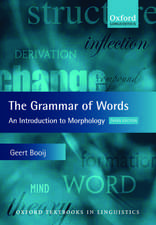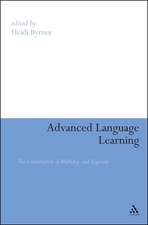Attention and Vision in Language Processing
Editat de Ramesh Kumar Mishra, Narayanan Srinivasan, Falk Huettigen Limba Engleză Hardback – 20 iul 2015
Language scientists have traditionally considered language in isolation from other cognitive and perceptual systems such as attention, vision and memory. In recent years, however, it has become increasingly clear that language comprehension must be studied within interaction contexts. The study of multimodal interactions and attentional processes during language processing has thus become an important theoretical focus that guides many research programs in psycholinguistics and related fields.
| Toate formatele și edițiile | Preț | Express |
|---|---|---|
| Paperback (1) | 677.37 lei 39-44 zile | |
| Springer India – 22 oct 2016 | 677.37 lei 39-44 zile | |
| Hardback (1) | 694.16 lei 39-44 zile | |
| Springer India – 20 iul 2015 | 694.16 lei 39-44 zile |
Preț: 694.16 lei
Preț vechi: 913.36 lei
-24% Nou
Puncte Express: 1041
Preț estimativ în valută:
132.83€ • 137.03$ • 110.85£
132.83€ • 137.03$ • 110.85£
Carte tipărită la comandă
Livrare economică 24-29 martie
Preluare comenzi: 021 569.72.76
Specificații
ISBN-13: 9788132224426
ISBN-10: 8132224426
Pagini: 250
Ilustrații: XV, 213 p. 23 illus., 6 illus. in color.
Dimensiuni: 155 x 235 x 17 mm
Greutate: 0.59 kg
Ediția:1st ed. 2015
Editura: Springer India
Colecția Springer
Locul publicării:New Delhi, India
ISBN-10: 8132224426
Pagini: 250
Ilustrații: XV, 213 p. 23 illus., 6 illus. in color.
Dimensiuni: 155 x 235 x 17 mm
Greutate: 0.59 kg
Ediția:1st ed. 2015
Editura: Springer India
Colecția Springer
Locul publicării:New Delhi, India
Public țintă
ResearchCuprins
Section 1: Attention and Vision in Spoken Language Comprehension and Production.- Chapter 1. Real Time Language Processing as Embodied and Embedded in Joint Action.- Chapter 2. Phonological Features Mediate Object-label Retrieval and Word Recognition in the Visual World Paradigm.- Chapter 3. The Complexity of the Visual Environment Modulates Language-mediated Eye Gaze.- Chapter 4. Visually Situated Language Comprehension in Children and in Adults.- Chapter 5. Vision and Language in Cross-linguistic Research on Sentence Production.- Section 2: Attention and Vision in Reading.- Chapter 6. Capturing Reading Processes in Connected Texts with Eye Movements and a Letter Detection Task.- Chapter 7. Reading in Thai: Visual and Attentional Processes.- Section 3: Attention and Vision in Bilingual Language Processing.- Chapter 8. Visual Cues for Language Selection in Bilinguals.- Chapter 9. In the Mind’s Eye: Eye-Tracking and Multi-modal Integration during Bilingual Spoken Language Processing.- Chapter 10. Spoken Word Mediated Interference in a Visual Task: Eye Tracking Evidence from Bilinguals.- Section 4: Language Processing in a Social Context.- Chapter 11. Adjusting the Manner of Language Processing to the Social Context: Attention Allocation during Interactions with Non-native Speakers.- Chapter 12. Seeing and Believing: Social Influences on Language Processing.
Notă biografică
Ramesh Kumar Mishra has a Ph.D. from the University of Delhi and is currently associate professor and Head at the Center for Neural and Cognitive Sciences, University of Hyderabad . He earlier taught at the Centre of Behavioural and Cognitive Sciences, University of Allahabad, India. Dr. Mishra has published widely in the area of psycholinguistics and cognitive science of language and has edited books in the area of language and cognition. His current research focuses on how language and other important cognitive processes like attention and vision interact during cognitive processing. Dr. Ramesh Mishra is on the editorial board of journals like Journal of Theoretical and Artifi cial Intelligence, Frontiers in Cognition. He also co-edits the International Journal of Brain, Culture and Cognition.
Narayanan Srinivasan is currently Professor and Head at the Centre of Behavioural and Cognitive Sciences, University of Allahabad, India. Professor Srinivasan was a visiting scientist at the Riken Brain Science Institute (2006-2012). He has a master's degree in electrical engineering from the Indian Institute of Science and subsequently earned his PhD in psychology from the University of Georgia, USA in 1996. He has been working at the Centre for more than a decade. His primary research interests are attention, perception, emotions and consciousness. He employs multiple methodologies to study cognitive processes. Professor Srinivasan has edited six books and a special issue and has published more than a hundred journal articles, book chapters and conference proceedings papers. He was the editor-in-chief of the International Journal of Mind, Brain, and Cognition and the associate editor of the journals, Frontiers in Cognitive Science, Cognitive Processing, Neuroscience of Consciousness, Royal Society Open Science and Psychological Studies.
Falk Huettig is a Senior Investigator at the Max Planck Institute for Psycholinguistics in Nijmegen, Netherlands and a Visiting Professor at the University of Hyderabad, India. He received a BSc and a MSc from the University of Edinburgh and a PhD in psychology from the University of York, UK. His main research interest is multimodal cognition. Other main interests include the effect of cultural inventions such as reading on general cognition in children, illiterate adults, and individuals with reading impairments; and predictive language processing. Falk Huettig is an editorial board member of the Journal of Memory and Language and editor-in-chief of Brain, Cognition and Culture.
Narayanan Srinivasan is currently Professor and Head at the Centre of Behavioural and Cognitive Sciences, University of Allahabad, India. Professor Srinivasan was a visiting scientist at the Riken Brain Science Institute (2006-2012). He has a master's degree in electrical engineering from the Indian Institute of Science and subsequently earned his PhD in psychology from the University of Georgia, USA in 1996. He has been working at the Centre for more than a decade. His primary research interests are attention, perception, emotions and consciousness. He employs multiple methodologies to study cognitive processes. Professor Srinivasan has edited six books and a special issue and has published more than a hundred journal articles, book chapters and conference proceedings papers. He was the editor-in-chief of the International Journal of Mind, Brain, and Cognition and the associate editor of the journals, Frontiers in Cognitive Science, Cognitive Processing, Neuroscience of Consciousness, Royal Society Open Science and Psychological Studies.
Falk Huettig is a Senior Investigator at the Max Planck Institute for Psycholinguistics in Nijmegen, Netherlands and a Visiting Professor at the University of Hyderabad, India. He received a BSc and a MSc from the University of Edinburgh and a PhD in psychology from the University of York, UK. His main research interest is multimodal cognition. Other main interests include the effect of cultural inventions such as reading on general cognition in children, illiterate adults, and individuals with reading impairments; and predictive language processing. Falk Huettig is an editorial board member of the Journal of Memory and Language and editor-in-chief of Brain, Cognition and Culture.
Textul de pe ultima copertă
This volume provides a comprehensive overview of the nature of attentional and visual processes involved in language comprehension. Key concerns include how linguistic and non-linguistic processes jointly determine language comprehension and production, and how the linguistic system interfaces with perceptual systems and attention.
Language scientists have traditionally considered language in isolation from other cognitive and perceptual systems such as attention, vision, and memory. In recent years, however, it has become increasingly clear that language comprehension must be studied within interaction contexts. The study of multimodal interactions and attentional processes during language processing has thus become an important theoretical focus that guides many research programs in psycholinguistics and related fields.
Language scientists have traditionally considered language in isolation from other cognitive and perceptual systems such as attention, vision, and memory. In recent years, however, it has become increasingly clear that language comprehension must be studied within interaction contexts. The study of multimodal interactions and attentional processes during language processing has thus become an important theoretical focus that guides many research programs in psycholinguistics and related fields.
Caracteristici
Explores language with regard to multimodal interactions which are a fundamental characteristic of the human mind
Discusses cutting-edge issues in current cognitive science and linguistics
Highly distinguished contributors from leading labs around the world
Includes supplementary material: sn.pub/extras
Discusses cutting-edge issues in current cognitive science and linguistics
Highly distinguished contributors from leading labs around the world
Includes supplementary material: sn.pub/extras



















